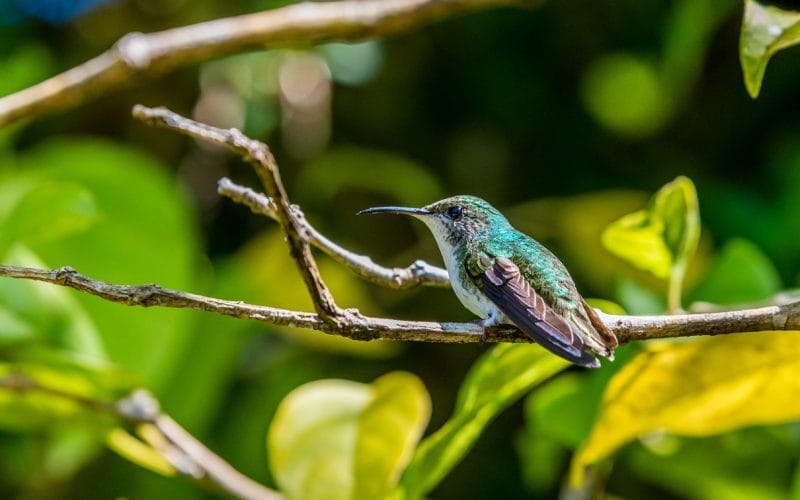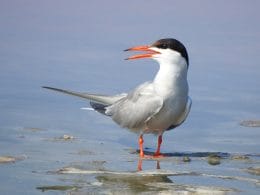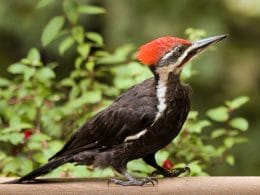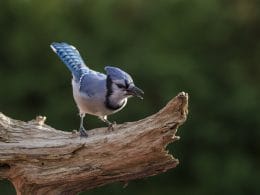Indiana is a populous Midwestern State with varied geography and landscapes. It’s one of the eight States that constitute the Great Lakes Region. Some of the best natural areas in Indiana are around Lake Michigan, the Ohio River, and the Wabash River.
On top of that, there are 65 other rivers with hundreds of creeks branching out of them. This adds up to approximately 24,000 total river miles extending left and right throughout the state. The woodlands, wetlands, and wildlife created around these huge freshwater reservoirs are admirable.
There are around 420 bird species in Indiana, all of them are amazing. However, we’ll focus on 6 hummingbirds in Indiana that are absolutely breathtaking.
Spotting All 6 Hummingbirds in Indiana
Most of the hummingbirds in Indiana are rare visitors in that area. Thus, to maximize your chances of spotting one of them, it’s best to really get to know them.
The following are basic facts about these birds, their main characteristics, and where you can find them. So read on!
1. Mexican Violetear

- Scientific name: Colibri thalassinus
- Length: 3.8 to 4.7 in
- Weight: 0.17 to 0.20 oz
- Wingspan: 5 to 6 in
The Mexican Violetear is a mass of blue-green iridescent feathers, with a thin and slightly curved black bill. It’s one of the medium-sized hummingbirds, so spotting it should be fairly easy. That is if you come across one these rare species of hummingbirds in Indiana.
Author Note: This bird is migratory, but its habits aren’t too regular. Typically, it traves South after the breeding season, but oddly enough, it forays north in unexplainable adventures.
One of the interesting habits of the Mexican Violetear is its courtship and family life. The males flaunt their colorful trappings to attract the females, but once that happens, they take a step back. The females then choose a suitable location for a nest, weave it, and lay two tiny eggs inside it.
The eggs take about 2-3 weeks to hatch. Their mothers usually take care of them completely, and mostly feed them insects, instead of nectar, to ensure their quick and healthy development. The breeding season lasts throughout the wet season. As soon as the dry season begins, the fledglings would be ready to leave the nest.
You can find these birds in deforested areas, where they’d be sucking nectar off flowering trees or orchards. They would also feed on the abundant little insects roaming around these places. The Mexican Violetear is a stubborn bird that would often be seen defending its food and territory.
2. Ruby-Throated Hummingbird

- Scientific name: Archilochus colubris
- Length: 2.8 to 3.5 in
- Weight: 0.1 to 0.2 oz
- Wingspan: 3.1 to 4.3 in
There are some substantial differences in the appearances of male and female Ruby-Throated Hummingbirds. For starters, the ruby thing is a feature that’s only found in the males of the species. They also have emerald green backs, black heads, and white bellies.
The females are smaller and shorter than the males, they have bright green backs, olive-green heads, and blue-green highlights on their tails. The female’s bill is slightly longer and more pointed than the male’s.
Top Tip: Ruby-Throated Hummingbirds stay fly north during the breeding season, and they might as well reach the Midwestern States. In the dry season, they migrate back South, and some of them take residence in a warm location all-year-round.
You can attract these hummingbirds to your backyard by setting up a feeder or planting some of their favorite flowers. Many people tried using a sugary syrup with great success. Just make sure to keep it fresh and clean. And keep an eye on the house cat which might try to hunt the birds!
3. Black-Chinned Hummingbird

- Scientific name: Archilochus alexandri
- Length: 3.5 in
- Weight: 0.1 to 0.2 oz
- Wingspan: 4.3 in
Unlike most hummingbirds, the male Black-Chinned Hummingbird isn’t bursting with neon colors. It actually has a darkly elegant appearance, with the lightest touch of purple on its throat. They’re another relatively rare species of hummingbirds in Indiana.
Incidentally, the females appear to be more discernible with their olive-green backs, white bellies, and long pointed black bills.
This bird is rather small and often doesn’t grow bigger than a sparrow. Despite their tiny size, the Black-Chinned are quite courageous. They’re often seen hovering over flowers and orchards, and at the same time, warding off intruders.
Courtship of these birds is quite a lovely sight. The male often gains substantial elevation, then suddenly dips 100 feet down. This show of bravery seems to affect the females nicely, and they head off to making a nest.
These hummingbirds favor tall trees surrounded by flowers. Other than that, they aren’t picky at all. So if that tall tree happens to be in a mountainous forest, a desert, a clearance, a garden, or even at a backyard in the suburbs.
Actually, backyards might be particularly attractive if they have a feeder with a constant supply of sugary syrup. The Black-Chinned Hummingbirds are quite fond of nectar, and that’s why they’d take residence where there’s an abundance of food.
4. Anna’s Hummingbird

- Scientific name: Calypte anna
- Length: 3.9 in
- Weight: 0.1 to 0.2 oz
- Wingspan: 4.7 in
Male Anna’s Hummingbirds are the perfect representation of that tropical bird species. They have the typical emerald-green scale-like feathers, magenta necks, and pointy bills. The females deviate a bit from that image, as they have a less intense green coloring and an overall unassuming appearance.
These hummingbirds are rather small, and their iridescent colors become dull green as they move away from the sunlight. So if you’re out birdwatching, there’s a much better chance to spot one of them in the midday when the sun is brightest.
One more thing might be a sign that there’s a hummingbird in the vicinity; which is a metallic screechy song this bird sings as it collects nectar from flowers. And speaking of getting food, Anna’s hummingbirds hover over flowers in a frenzy of movement that doesn’t reflect a particular pattern.
Author Note: These birds are quite accustomed to humans and urbanized areas, so they don’t stick to forests and high trees as their preferred residential locations. You can easily find them in gardens, parks, backyards, riverside shrubs, as well as woodlands of course.
This bird’s diet is as varied as its habitat. It’s especially fond of eucalyptus flowers, in addition to the nectar of gooseberry plants, manzanita, and currant. It would also welcome a snack of small insects and tree sap.
5. Calliope Hummingbird

- Scientific name: Selasphorus calliope
- Length: 3.1 to 3.5 in
- Weight: 0.1 to 0.1 oz
- Wingspan: 4.1 to 4.3 in
This one is among the smallest birds you could come across. The Calliope Hummingbird isn’t too much of an attention seeker, and it’s not just about its tiny size. Its colors are also not that flashy, as both males and females have muted bronze-green backs and white bellies.
A defining feature for this species is a little spot of color. The males have a magenta patch on their throats that sets them apart from most other hummingbirds. It has a slight resemblance to an Allen’s hummingbird, and the female Calliope can easily get mistaken for a Rufous.
The Calliopes are migratory birds that travel northward in spring, often taking a route close to the coastline. They rarely travel the whole distance in one go, and usually, prefer making several stops along the way.
By the fall, they take a return route southward adjacent to the mountains. And as expected, they don’t break their leisurely habit of stopping wherever their heart desires. As the winter sets in, they invariably settle down in the warmest parts of Mexico.
The courtship of these birds is worth watching, as the male performs deep dives in the air then takes a steep curve and flies back into high altitudes. As they get their family starting rituals going, they soon follow up with the nesting phase.
This is one of the best times to look for Calliope Hummingbirds. That’s because they’re rather predictable in selecting their nesting locations. They like mountain meadows, brush beside the streams, and regenerating forests.
6. Rufous Hummingbird

- Scientific name: Selasphorus rufus
- Length: 2.8 to 3.5 in
- Weight: 0.1 to 0.2 oz
- Wingspan: 4.3 in
Rufous Hummingbirds are so small and so inconspicuous that spotting them is such a challenge for birdwatchers. Usually, it’s the male Rufous they set their sights on, as it’s slightly easier to identify.
The males of this species have copper-orange backs, dark wings that contrast nicely with that, and a bright reddish-orange patch on their throats. The females are mostly grey-green, with rust highlights on their flanks. Both males and females have black straight pointed bills.
The flight pattern of this bird is mostly swift darting from point to point. It’s agile and clearly enjoys a good chase. Rufous Hummingbirds are often seen doing elaborate air maneuvers to catch an insect in midair or chase away an intruder.
This bold and audacious hummingbird isn’t afraid of humans, so it often forays into backyards, suburban gardens, and parks. It appears to be a bit more comfortable at higher altitudes though. Mountain meadows are by far their most favorite hangouts.
Author Note: Rufous Hummingbirds typically spend their winters in Mexico. Then, they get ready for a migratory adventure as the breeding season approaches. During these long flights, the Rufouses get rather aggressive and hog every favorable spot to themselves.
Having boosted their confidence in that manner, they go on with their courtship rituals. Much like their precise air maneuvers while feeding, they have just as nicely choreographed moves to attract their breeding females.
The nesting birds are quite clever at weaving new homes from spider webs and insect cocoons. They put together dry leaves, grass blades, and any other practical items, then they glue everything together with the delicate web strands.
The newly laid eggs are extremely tiny and rarely exceed a couple. The female then feeds her hatchlings little insects to fatten them up. Soon, the fledglings become strong enough to leave the family residence.
Interesting Facts About Hummingbirds
Hummingbirds are unique in more ways than one. Of course, there’s their neon flamboyant color and funny flight patterns. But there are some really interesting facts that only the avid birdwatchers know! Here are some of these.
- Hummingbirds belong to the biological class Apodiformes, which also includes swifts and treeswifts. This is a category of birds that have stumpy weak legs and small feet. Their odd anatomy makes perching, walking, and hopping pretty difficult.
- Hummingbirds have far less feathers compared to other bird species. This is mostly to minimize their weight, which helps with their air maneuvers and swift flight.
- A hummingbird’s heart beats around ten times faster than a human’s. The former goes with 1200 beats per minute, while the latter reaches 120 beats per minute, and that’s often while jogging.
- It’s hard to imagine such slender birds overeating, but that’s pretty much what they do. Hummingbirds need to fill up to the point of ingesting half their weight in nectar to stay healthy.
- The high need for non-stop feeding these birds have is caused by their super-efficient metabolism. They can convert 97% of the ingested sugar to energy, and they do all that burning in less than half an hour.
- The long bills of hummingbirds look a lot like straws, so we often assume that they suck nectar. In reality, they lick the sweet syrup at a very high speed.
- These tiny birds show impressive stamina while migrating. They can fly 500 miles in a single stretch, and travel more than 4000 miles in these seasonal trips.
Conclusion
Indiana is an amazing destination for naturalists who enjoy exploring wildlife and the great outdoors. As for birdwatchers, there’s definitely plenty to see. There are hundreds of bird species that take residence in various parts of the picturesque State.
Hummingbirds are among the most interesting birds of Indiana. Unfortunately, there aren’t too many of them in this Midwestern State. However, the ones that arrive during the breeding season are definitely worth checking out.
We hope you enjoyed our guide on the top 6 hummingbirds in Indiana.
FAQ
To find out where recent sightings of hummingbirds have been, try eBird. You can search for the latest sightings or particular species or what has been seen in a certain area.
Hummingbirds are not that common in Indiana. As the Ruby-throated Hummingbird is most common across the country, it is probably most likely to be the one spotted in Indiana.
As hummingbirds are not that common in Indiana, you best bet is to set up a hummingbird feeder in your garden and see if they visit. Otherwise, try your local gardens or anywhere that has flowering plants.










